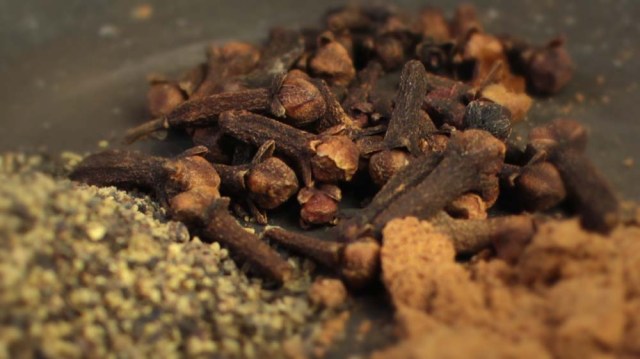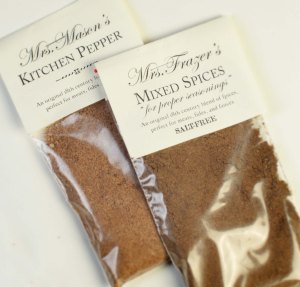Proper seasoning can make all the difference between a bland chunk of meat and a course fit for royalty. We decided to dig through a collection of 18th and early 19th century cookbooks to see which spices were mentioned. We also took one of the more recognized books and looked at the frequency by which the spices appear in the recipes.
It’s seems to me to be a fairly safe and logical conclusion that the frequency by which particular spices, herbs, and seasonings were mentioned may lend insight into which were more popular. Granted, I can’t be too dogmatic in my conclusions. First, my sample is small. Second, taste preferences in the 18th century varied regionally and culturally just as they do today. So I wouldn’t attempt to apply my conclusions to every 18th century English-speaking cook, but this exercise seems to be an interesting starting point toward understanding preferences of the day. This is intended to be one snap shot of perhaps many, and hopefully helpful in a general sense for the interested reenactor or historical foodie who, perhaps, wishes to put together a spice kit or stock a spice box.
My sample includes the 1797 cookbook, The Lady’s Assistant for Regulating and Supplying her Table by Charlotte Mason; English Housewifery, by Elizabeth Moxon, 1764; The Art of Cookery, Hannah Glasse, 1774; The Scotch Forcing and Kitchen Gardener, by Walter Nicol, 1798; The English Art of Cookery, by Richard Briggs, 1788; and The Art of Gardening, by John Wollridge, 1700.
The Collective List of Seasonings:
Salt — Sure, salt is a given as far as seasonings go. But if you’ve ever run across in the old recipes the terms “bay salt,” “sea salt,” “salt-petre,” etc, and wondered what specifically was being referenced, a good explanation can be found in Mason’s book:
Other seasonings include: Allspice (Jamaican Pepper), Anise Seed, Basil, Bay leaf, Caraway, Cayenne, Chives, Cinnamon, Clove, Coriander, Fennel, Garlic, Ginger, Horseradish, Lemon Zest, Mace, Marigold Blossoms, Marjoram, Mint, Mustard, Nutmeg, Parsley, Pepper (Black and White), Rosemary, Sage, Savory, Sorrel, Tarragon, Thyme, and Turmerick.
I would not be at all surprised if I missed a few, but it’s pretty safe to say that this includes most of the spices found in the best-supplied English spice cabinets.
The Frequency by which Seasonings were Mentioned:
We took Moxon’s book and analyzed it for usage frequency. Of course, Salt is the most commonly included ingredient, mentioned nearly 300 times. Second was lemon peel or zest — mentioned 198 times. Then there is pepper with 158 mentions. Then nutmeg with 120, followed close behind by its aril companion, mace, with 110. Beyond that, the numbers drop off: parsley, 58 mentions; cinnamon, 30; ginger, 27; and cloves, 15.
Other Cryptic Seasonings:
We can’t overlook the phrase “sweet herbs,” as it is mentioned in nearly every period cookbook. The term remains more of a suggestion than a prescription of specific herbs. In nearly every case, “sweet herbs” referred to a bundle of fresh herbs — typically aromatics. I did find two specific recommendations: one for a combination of thyme, parsley, sweet marjoram, and savory; the other for sage, sweet marjoram, thyme, and mint. Marjoram and thyme, given all the honorable mentions in other recipes, seem to be the most typical components to these “sweet herb” bundles.
“Kitchen Pepper” is mentioned in Mason’s book, as is the phrase “Mixed Spices” in Mrs. Frazer’s 1795 book, “The Practice of Cookery.” These were spice blends which used some of the more common seasonings. Recipes are found in the respective books. Frazer’s blend includes allspice, pepper, nutmeg, and clove, while Mason’s blend primarily includes salt, pepper, ginger, and cinnamon.
We’ve reproduced these spice blends and made them available at Jas. Townsend & Son. We also carry a number of bottles, pots, and cans perfect for storing your favorite seasonings.




Pingback: Interesting Blog Post on 18th Century Spices - Valley Forge Black Pots
In the book “Savoring the Past” by Barbara Ketcham Wheaton there are no less than 8 spice and herb blends dating from 1555 to 1758. Blends have been around for a while it seems. Spices were expensive and transported in whole form and ground usually right before use. The blends afforded a way to have seasoning readily available by the cook.
Pingback: Elder Wine, A Perfect Libation for a Regency Holiday « Jane Austen's World
In my mom’s kitchen we make a savory called Pizza Geena (that is phonetic I have no idea how to spell or speak in Italian, nor can I tell you what the words actually mean). Made for Easter to break the meat fast , it is loaded with meat and cheeses.The recipe calls for a crust very similar to what you do here. Once I asked her why not use cold fats and she had no answer. Considering the amounts of meats et al in the pie, it wasn’t for a numer of years whebn I tried my own concept I realised, the crust cannot handle the filling unless the fats and water are hot. This makes for a very dry painfull dough to work. I always helped as my mom’s shoulder was hurting from it, and I learned to make pizza dough for same reason. Mom was not going to make it alone and I loved to cook. Little Red Hen was always quoted. As a History Major who can forget John Smith. Those who do not work, do not eat!
This pie crust is wonderful and I will make some pies this week or next.
This is how to make a “Pot Pie” really work well, and varients are Jamaica Beef patty as well as Empanada’s/Welsch Pasties.
Just break out a flagon of ale to go with one!!!
thanks
chris
NYNY
Pingback: Pour Some Sugar (and Salt and Pepper) on Meat : TMBBQ
Reblogged this on LET'S BURN SOMETHING.
Pingback: Salmagundi (Bits and Pieces) | pint + poppy
Pingback: More Links | pint + poppy
Kevin, I think I have all of these herbs and spices! Good to know I would’ve been all set in an 18th century English kitchen!